Working Time:
9.30-18:00(GMT+8)
International Workshop
on Software Engineering and Applications
 1, Chengdu Research
Base of Giant Panda Breeding 成都大熊猫繁育基地
1, Chengdu Research
Base of Giant Panda Breeding 成都大熊猫繁育基地
The Chengdu Research Base of Giant Panda Breeding not
only offers a chance to see these amazing creatures up
close in their natural environment, it also provides an
in-depth look at these laid-back animals. Established in
1987, the facility began with just six rescued giant
pandas, a number that has since grown to exceed 80
animals and seen well over 120 panda births. Tours also
include a chance to visit the on-site museum featuring
exhibits dealing with the reproductive problems of these
fickle bears. Often found sleeping, pandas are their
liveliest during morning feeding times, so plan your
trip accordingly.
A great way to get the most out of a visit is to join an
organized tour, such as the Half-Day Chengdu Panda
Breeding Center Tour (if you can, be sure to select the
upgraded baby panda holding option; hotel pickup and
transport is included). For an even more unforgettable
experience, consider taking the Panda Rescue Center
Volunteer for a Day package, which allows you to prepare
food for these lovable creatures, as well as receive a
private tour of the facility (hotel pickup, transport,
and lunch provided).
For a chance to see pandas in the wild, book a trip to
the vast Wolong Nature Reserve 130 kilometers west of
Chengdu. Covering an area of 2,000 square kilometers,
this superb conservation area is surrounded by mountains
and is home to 60 different types of mammals, as well as
300 species of birds and 4,000 kinds of plants,
including giant redwood trees.
Address: 1375 Panda Road, Northern Suburb, Chengdu,
Sichuan
Official site: www.panda.org.cn/english/
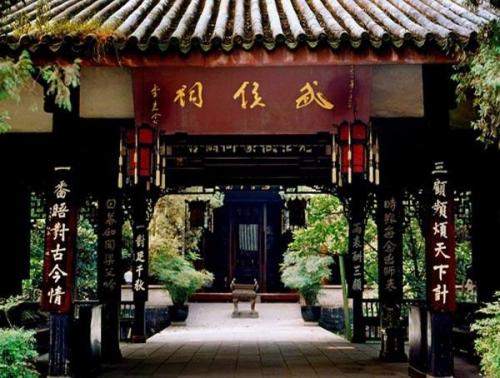 2,
The Chengdu Wuhou Shrine 武侯祠
2,
The Chengdu Wuhou Shrine 武侯祠
One of Chengdu's oldest temples, the splendid Chengdu
Wuhou Shrine dates back to AD 302 when it was built in
honor of Zhuge Liang, a famous strategist and statesman
who later served as Chancellor of the Shu Han empire
from AD 221 to 263 (for his services, Liang was made a
prince). Rebuilt in 1672, this vast temple complex
boasts many interesting features, including its large
central hall with a gilded clay figure of Zhuge Liang
(the two small figures on either side of the Prince are
his son and grandson).
Also worth seeing is the temple dedicated to Liu Bei,
ruler of the Shu Han Empire who's buried in the adjacent
12-meter-tall burial mound. Other notable features are
the 28 terra-cotta statues of ministers, generals, and
high officials of the state of Shu Han displayed in the
east and west covered walks, as well as a number of
ancient inscribed stone tablets featuring poems and
writings from this important period in China's history.
Address: 231 Wuhouci Dajie, Wuhou District, Chengdu,
Sichuan
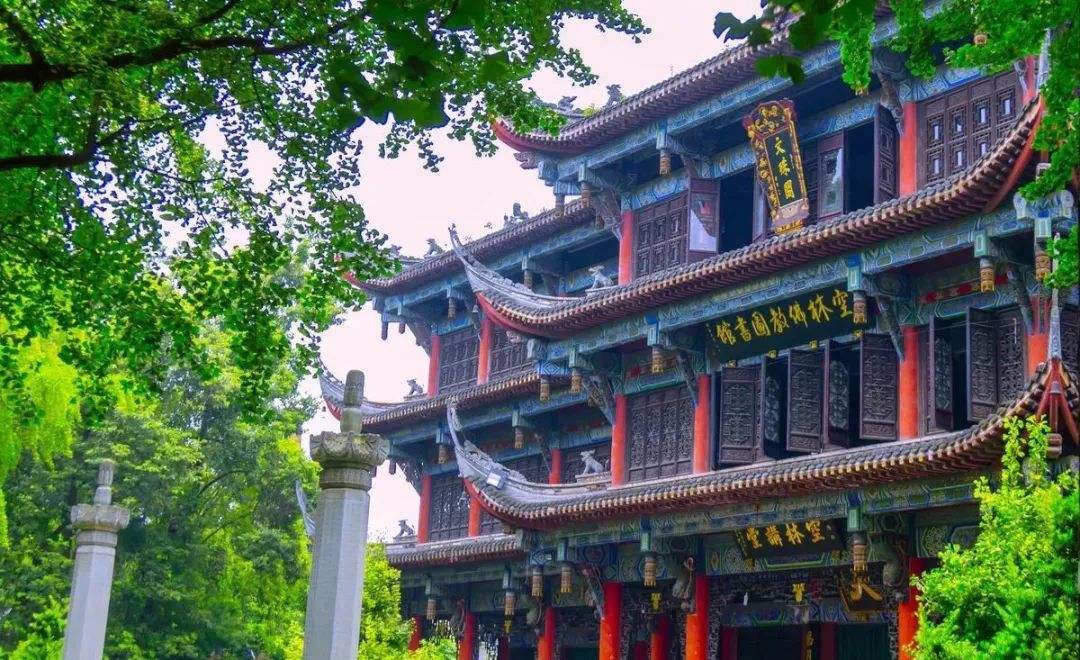 3, The Wenshu Monastery (Manjushri Monastery) 文殊院
3, The Wenshu Monastery (Manjushri Monastery) 文殊院
Covering an area of more than 12 acres, the Wenshu
(Manjushri) Monastery consists of five separate temples
built from wood and stone. The complex was constructed
in 1691 above the ruins of an earlier monastery dating
from the time of the Southern Dynasties between AD 420
and 589. Highlights include the Hall of Shuofa Tang with
its 10 iron statues of Buddhist guardian gods from the
Song period of AD 960-1279, as well as the more than 100
bronze sculptures of Buddhas and Buddhist saints from
the Qing era between 1644 and 1911, and many more made
from materials such as jade and wood. The site also
contains numerous other important cultural relics,
including paintings and calligraphy by leading Chinese
artists and writers. (Be sure to spend some time
enjoying a traditional beverage at the on-site
teahouse.)
Address: 66 Wenshu Yuan Jie, Qingyang District, Chengdu,
Sichuan
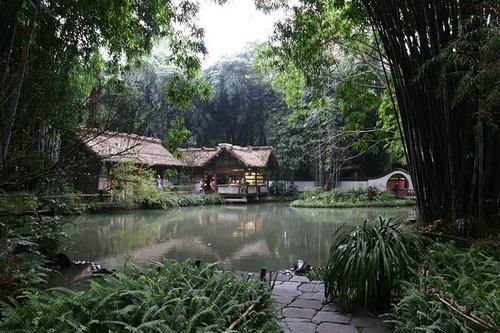 4,
Du Fu Thatched Cottage 杜甫草堂
4,
Du Fu Thatched Cottage 杜甫草堂
The sprawling Du Fu Thatched Cottage complex (Dù Fu Cao
Táng) in Chengdu covers 24 acres and is dedicated to one
of China's best-known poets. The site replicates the
home in which Du Fu lived between AD 759 and 763 and in
which he wrote more than 250 of his best-known poems.
Located on a picturesque bend of the Huanhuaxi River,
the complex features lush gardens, numerous pavilions,
and lovely bridges and pathways. While not original,
most of the buildings date from between 1500 and 1800
and were carefully restored in 1949. Other highlights
include the Gong Bu Memorial Hall, with its exhibits
portraying the life and work of Du Fu, complete with a
foreign language section; the reconstructed cottage
itself, a simple structure with a study, bedroom, and
kitchen; and the Hall of Great Poets showing scenes from
his most famous poems, including one dedicated to the
destruction of the original cottage by a storm.
Address: 28 Caotang Road, Qingyang, Chengdu, Sichuan
 5, Chengdu Culture Park and the Sichuan Opera 文化公园和川剧
5, Chengdu Culture Park and the Sichuan Opera 文化公园和川剧
In Chengdu's Cultural Park (Wenhua Gongyuan) in the
western part of the city stands the old Taoist Qingyang
Temple dating from the Tang period of AD 618-907 (the
present buildings are from the Qing period between
1644-1911). Particular highlights include the Pavilion
of the Eight Trigrams (Bagua Ting), with its eight stone
pillars and intricate carvings of dragons and other
symbols from Chinese culture.
The park is where you'll find the Shufeng Sichuan Opera
House, one of the city's most important cultural
destinations and home to numerous regular performances
of traditional Chinese music and theater. It's here
you'll be able to experience the famous "Bian Lian,"
where performers in brightly-colored masks seemingly
undergo "face-changing" as they seamlessly swap masks
with various expressions with a flick of a traditional
Chinese fan. Amazing! Also worth a visit, People's Park
is the city's oldest public park and is notable for its
many important monuments, including the historic Railway
Protection Movement Monument.
Address: 23 Qintai Lu, Chengdu
 6, Leshan Giant Buddha 乐山大佛
6, Leshan Giant Buddha 乐山大佛
The Leshan Giant Buddha, a colossal stone statue of
Maitreya, has been a UNESCO World Heritage Site since
1996. Standing 71 meters high and carved directly from
the surrounding rock, this amazing feat was started by a
Buddhist monk by the name of Haitong in AD 713. After
his death, the work was continued by a number of other
monks and artists until it was eventually completed in
AD 803. Today, the figure is the largest sculpture of
Buddha to be found anywhere in the world and attracts
pilgrims and tourists from far and wide (it's also
responsible for the saying, "The mountain is a Buddha
and the Buddha is a mountain").
One of the best ways to enjoy a hassle-free trip is to
book a private tour, such as the first-rate Day Trip to
the Leshan Grand Buddha from Chengdu. Highlights of this
popular day trip include an English-speaking guide, who
will lead you to a few different lookout points from
which to view the Buddha (including from an optional
river cruise, if you so choose), along with a private
tour of Lingyun and Wuyou Temples. Included with your
trip are lunch at a traditional Chinese restaurant, as
well as pickup and drop-off from your hotel in Chengdu.
Location: Leshan, Sichuan
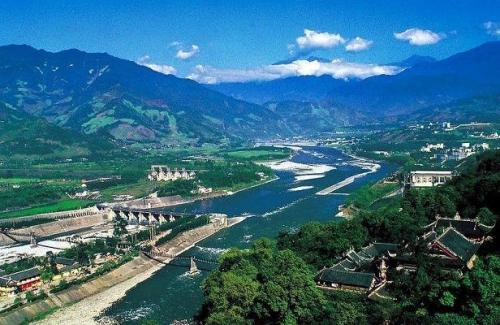 7, Dujiangyan Irrigation System
都江堰
7, Dujiangyan Irrigation System
都江堰
Constructed in 250 BC, the fascinating Dujiangyan
Irrigation System, near the town of Guanxian on the
upper reaches of the Minjiang River, some 55 kilometers
northwest of Chengdu, is well worth a visit. Constructed
to prevent catastrophic flooding, this amazing system
included a network of earth dams with sections branching
out into tributaries and canals to irrigate fields. The
system comprises interestingly named components such as
the Fish's Jaws, which functions as a watershed and
dike; the weir known as Flying Sands (Feisha Yan); and
the canal, the Neck of the Precious Bottle (Baoping
Kou). As a result of this ingenious system, the Minjiang
hasn't flooded for more than 2,200 years, and the
Chengdu Plain of central Sichuan has become one of
China's most fertile regions.
A nearby attraction that's well worth visiting is the
Cave of the Heavenly Master (Tianshi Dong), where Zhang
Daoling, the founder of the Taoist religion, taught in a
cave in Mount Qingchengsahn. The temple dates from the
Sui period of AD 589 to 618 and includes a terra-cotta
likeness of Zhang Daoling and three statues dating from
AD 723 representing Fuxi, Shengong, and Xianyuan, three
rulers said to have lived in China in prehistoric times.
A great way to enjoy the Mount Qingchengsahn area while
at the same time taking in the must-see irrigation
system, along with a number of other nearby points of
interest, is the fun Qingcheng Mountain and Dujiangyan
Irrigation System Day Trip from Chengdu. After departing
your Chengdu hotel, you'll spend a full day exploring
some of the most beautiful scenery in the Sichuan
region's Qingcheng Mountains, along with its many
well-preserved temples. The undisputed highlight, of
course, is Dujiangyan. In addition to explaining the
workings and significance of this marvelous feat of
engineering, your English-speaking guide will also
introduce you to great traditional food over lunch.
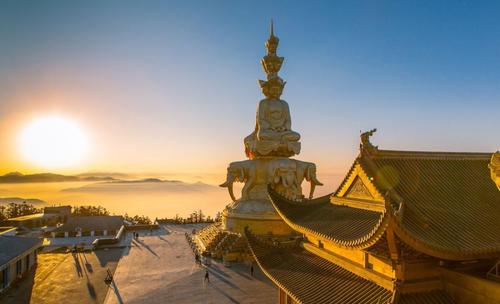 8,
Mount Emei 峨眉山
8,
Mount Emei 峨眉山
Mount Emei (Emeishan), dedicated to the Bodhisattva
Puxian, stands 160 kilometers southwest of Chengdu and
is well worth a visit. The mountain's highest peak, the
Peak of the Ten Thousand Buddhas (Wanfo Ding), reaches a
height of 3,099 meters and is revered by Chinese
Buddhists as one of the four Holy Mountains, the others
being Mount Wutaishan in Shanxi province, Mount
Jiuhuashan in Anhui province, and Mount Putuoshan in
Zhejiang province. As shrouded in legends and myths as
they are in clouds and mists, the first Taoist temples
on Mount Emei were built during the Eastern Han dynasty
from 25-220, and from the Tang period of AD 618-907
onwards, it became one of the major destinations of
Buddhist pilgrims due to its more than 200 shrines (20
temples and monasteries still survive).
You can find more travel guideline via the link:
https://wikitravel.org/en/Chengdu
